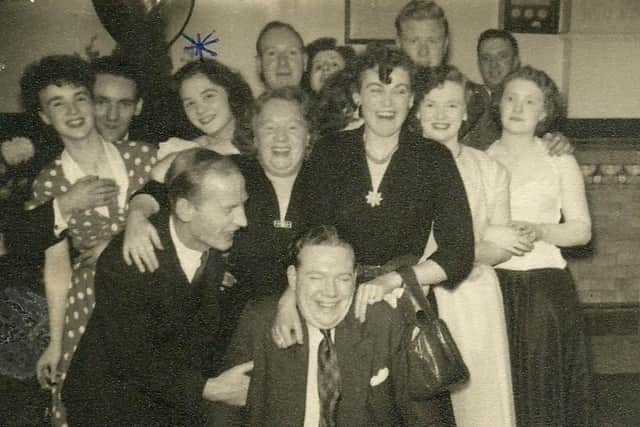Nostalgia with Margaret Watson: The Playhouse was the best cinema in Dewsbury
and live on Freeview channel 276
Margaret Watson writes: This attractive art deco building was erected in 1930 on land on Crackenedge Lane, formerly occupied by James Austin and Sons, later to become Austin Steel Works, Thornhill Lees.
Austin’s was pulled down to make way for the Playhouse, and 60 years later the Playhouse was pulled down to make way for Wilkinson’s store, known today as Wilko’s.
Advertisement
Hide AdAdvertisement
Hide AdFew of us will ever forget the splendour of the Playhouse, one of the most palatial cinemas in the north of England.


It could seat 1,700 and was designed by Robert Cromie, one of the most eminent cinema architects in the country.
It cost £60,000 to build and its chief investors were two heads of local businesses, Ashworth Son and Company Ltd, Dewsbury, and Messrs Lee and Sons, Earlsheaton.
A former Dewsbury MP, Colonel E W Pickering, was also an investor, and I’m sure all three would have agreed that they’d got their money’s worth.
Advertisement
Hide AdAdvertisement
Hide AdThe Playhouse was modern as well as being distinctly unusual in character and like all art deco buildings was plain and dignified.
It was built in white stone throughout and illuminated with floor lighting and neon-gas tubing.
The cinema attendants all wore smart uniforms, including the waitresses who worked in the splendid cafe and the organist who played the magnificent organ nightly.
The building of the Playhouse was the icing on the cake for Dewsbury, which in the 1930s was developing at a pace and attracting thousands of visitors weekly.
Advertisement
Hide AdAdvertisement
Hide AdNo money was spared when it was being built and the key word throughout was – luxury.
A special feature was the cafe restaurant on the first floor, the size of which was 43ft by 30ft, and instead of having the usual small windows, it was provided with one large window - 40ft long and 11ft high.
This provided the cafe with a shop window which could clearly be seen from outside, the effect of which had to be seen to be appreciated.
At night, when illuminated, it added much to the Market Square just across the road, and I make no exaggeration.
Advertisement
Hide AdAdvertisement
Hide AdEveryone who visited the Playhouse will remember the grand staircases, 10ft wide, which led from the entrance hall to the tea-room and the balcony.
The entrance hall was 55ft long by 22ft wide and the entrance to the stalls was arranged through an inner lobby so as to avoid draughts at the back of the stalls.
The cinema had been specially designed so the slope of the floor provided a perfect sight-line for every seat without the picture screen being unnecessarily high, and there were no columns or piers to obstruct the view.
The seats were counter-weighted and fitted with rubber buffers so there would be no noise to detract from the full effect of the “talkie” pictures which were just replacing silent films.
Advertisement
Hide AdAdvertisement
Hide AdA big attraction at the Playhouse was the organ which was played during the interval.
Only top organists were invited to play.
One resident organist in the 1930s was Vincent Trippett, who from his early youth had distinguished himself as a musician of exceptional ability.
Tragically, he died in 1937 at the young age of 28, only a few days before he was due to broadcast from the Playhouse itself.
The detailed programme for that event had been published in the current issue of the Radio Times that week.
Advertisement
Hide AdAdvertisement
Hide AdHe was such a popular personality that hundreds of Dewsbury people turned out for his funeral.
The picture above was sent in some years ago by Ray Brace.
Ray’s sister, Barbara, had been an usherette at both the Playhouse and Regal – later to become the Essoldo.
One of the managers at the Playhouse was Bill Spink, who himself had also been a manager at the Regal.
The picture, taken in the 1950s, also shows some of the other members of staff who worked there, pictured in happy mood.
Advertisement
Hide AdAdvertisement
Hide AdRay, himself, had been a manager at the Empire Theatre in Dewsbury, sadly demolished in the 1960s due to falling attendances.
He remembered attending all five cinemas in Dewsbury, including the Pavilion at Ravensthorpe, and because he was working just round the corner at the Empire, he was allowed free entry.
Most people of my generation will remember attending the ABC Minors every Saturday morning, which the Playhouse set aside for children only.
Many mothers were happy to deposit their children there while they went shopping and returned to take them for lunch at one of the nearby cafes.
Advertisement
Hide AdAdvertisement
Hide AdThe fish and chip snack bar, situated almost next door to the Playhouse, was a popular choice, but only if the children had behaved themselves.
Few of us can forget those gorgeous fish and chips accompanied by wafer thin slices of bread and butter and a glass of limeade. Happy days.
Ironically, the Playhouse might have gone and also the Empire Theatre, as well as all the other cinemas, but the fish and chip bar still lives on.
Just as the Empire closed due to the arrival of the silver screen, every single one of the town’s cinemas were also to close due to the arrival of television.
Advertisement
Hide AdAdvertisement
Hide AdDewsbury is not alone when it comes to changes like these in our town centres and how we spend our leisure time.
The same is happening all over the country. Indeed all over the world, as people shop online, and watch all the latest films in the comfort of their front rooms.
* My grateful thanks to people like Ray Brace and other local historians who help me with photographs and information about old Dewsbury.